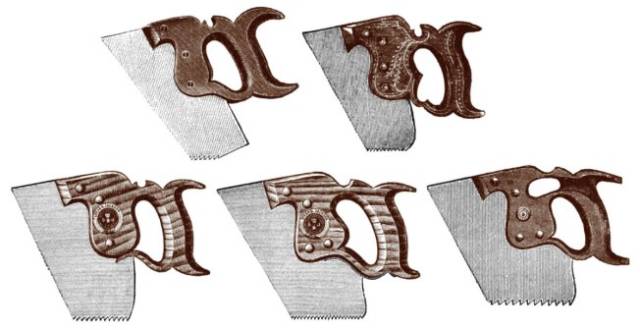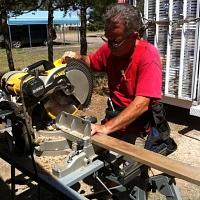
Jeff Vandenberg
in about 11 years
Apple Wood and Saws
Woods Used in Saw Handles
Posted by Jeff Burks
saw-handles-e

Although one is not apt to think of the apple tree as a source of timber, as a matter of fact at least 2,000,000 board feet of apple lumber is manufactured annually into saw handles. This, too, is about the only important use to which it is put, though small amounts are made into smoking pipes, and miscellaneous articles of turnery. The wood was formerly used for shuttles and gave excellent satisfaction, but has been entirely superseded by persimmon and dogwood. As a fuel-wood apple has few superiors.
Apple wood is usually the product of old orchards which are removed on account of age. Owing to the inroads of pests of various kinds during the last few years, a comparatively large amount of apple timber has been offered for sale, especially in the Middle West, where old trees are being replaced by new. The supply of this timber comes from Kentucky, Ohio, Indiana, Illinois, Michigan, Pennsylvania, New York, Delaware, New Jersey and Maryland.
Small lots are occasionally imported from Canada. It is interesting to note that when the collectors inspected the shipments they assessed it as “cabinet wood not further manufactured than by sawing.” The importers were dissatisfied by this classification and succeeded in convincing the collectors that apple wood is never used for cabinet making purposes, but almost exclusively for saw handles. The Board of General Appraisers sustained the importers’ contention and the wood enters as plain lumber.
Apple lumber is sawed from butts which run two feet or more in length, occasionally reaching eight feet long. Bolts less that thirteen inches in diameter are ordinarily not used “for the reason,” as a manufacturer explains it, “if the butt is smaller than that the wood is worthless for making saw handles, since certain width clear of heart is required.”
Some logs are shipped to the factories and sawed there. More often the manufacturer buys the material sawed into lumber from 6 to 6½ inches wide and 1⅛ to 1 3/16 inches thick. The length of piece required for a saw handle is nine inches.
When the timber is first cut it has a reddish yellow color. It is customary to subject it to a steaming process, which reddens and deepens the color and renders it more uniform. To secure the best results the steaming must be done after the timber is cut and before the sap is dried out.
This is accomplished by placing the green wood in a tightly closed box or room varying from thirty-six to seventy-two hours, depending on the length of time the timber has been cut; the greener the material the less time required in the steam box to get good results. After steaming, the lumber is piled in the open and air-seasoned for from two to three years. Before being used it is thoroughly kiln-dried.
Following is a brief description of the processes of manufacture of Disston handsaw handles: “The thoroughly seasoned lumber is planed down to an even thickness and then sawed into small pieces, generally of such size that two handles may be made from each of them. The markers then trace the shape of the handles with lead pencils around sheet steel patterns.”
“They are then cut out by the band saws, after which a hole is bored in the center through which the jig saw enters and cuts out the center piece. They are now sent to the ‘nosing’ machine, where the nose is shaped. ‘Jimping’ is the next operation. In this the roughly cut handles are brought into contact with swiftly revolving cutters, and the edges are rounded.”
“The handles now pass on to the filers, who work them into the finished shape. This is followed by sand-papering on belt machines. The next step is varnishing, after which comes ‘slitting,’ as it is termed, or the process of sawing the slot in the handle in which the blade rests. In connection with this operation the handles are bored and countersunk for the bolts or screws. If the handle is to be carved that work is now done, after which it is taken to the polishing room.”
Apple wood, being hard, of very fine and uniform texture, capable of receiving a high polish though of little natural lustre, is very well adapted for handsaw handles. The deep, uniform color makes it attractive and the trade has become so used to the wood for the better grades of handles that none other is considered satisfactory.
The price of the material is so high, however, that for the cheaper saws beech is a common substitute. What beech lacks in natural beauty and high polish is offset for general utility by its greater strength, toughness and vitality. Other woods used for handsaw handles are black cherry, red gum and maple and, where specially ordered, black walnut and mahogany. Handles for long or cross-cut saws are made principally of beech and maple, though some few are of hickory.
In a government report on the wood-using industries of Michigan, it stated that 50,000 board feet of apple wood is used annually for handles. “The only wood in the whole industry (handle) costing an average of $50 a thousand feet was apple, obtained in old orchards where the trees are no longer profitable for fruit. Apple wood is peculiarly fitted for saw handles and most of it is put to that use. Black cherry is employed for the same purpose, but in Michigan it costs $14 a thousand feet board measure and is much cheaper than apple wood.”
S. J. R.
Hardwood Record – September 25, 1912
—Jeff Burks
Jeff Vandenberg aka "Woodsconsin"
7 Comments
Very interesting read, thanks for sharing Jeff .
Jaybird
Quit welcome
Jeff Vandenberg aka "Woodsconsin"
Stupid inflation. I’d make everything out of apple if it were $0.05/bf.
Losing fingers since 1969
Very interesting. I always wondered what apple wood could be be used for.
Also good for cutting boards, rolling pins, chisel handles and mallets. The biggest issue is getting big pieces.
I live in apple country (North Central Washington). Every year, I drive by some field where someone has pulled a hundred acres of apple trees, pushed them into piles and will burn them.
In short, apple wood is plentiful, as is cherry, pear and some other fruit woods. I’ve found all of it makes beautiful kitchen utensils (spoons, spurtles, spreaders, etc.).
The grain is tight and it seems to hold up better than most store bought versions. In fact, I don’t complain if my wife tosses them in the dish washer, but I do re-oil them on occasion.
In short, remarkable stuff, that fruit wood.
Man id pay shipping if you could send some of that to me.
Jeff Vandenberg aka "Woodsconsin"











